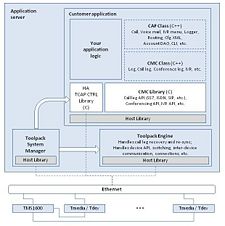Toolpack
(created section for OS) |
(clean up and simplification) |
||
| Line 6: | Line 6: | ||
[[Image:Toolpack-screenshot.jpg|thumb|225px|Screenshot of Web Portal interface]] | [[Image:Toolpack-screenshot.jpg|thumb|225px|Screenshot of Web Portal interface]] | ||
| − | The [[Web Portal]] is a web-based Operations, Administration, Maintenance, and Provisioning ([http://en.wikipedia.org/wiki/OAMP OAM&P]) tool that enables the user to easily configure a TelcoBridges system and to monitor its performance. The Web Portal has been designed with an eye | + | The [[Web Portal]] is a web-based Operations, Administration, Maintenance, and Provisioning ([http://en.wikipedia.org/wiki/OAMP OAM&P]) tool that enables the user to easily configure a TelcoBridges system and to monitor its performance. The Web Portal has been designed with an eye to the simplification of the configuration process with the use of intuitive web-based screens. The Web Portal is accessed from any computer using a standard web browser (Internet Explorer / Firefox) and is hosted by the Toolpack application server enabling the complete configuration of Tmedia/Tdev units. |
| − | + | ||
| − | + | ||
| − | + | ||
| + | Using the Web Portal, the developer defines the physical hardware and its interfaces, the signaling interfaces, and the classification of functions into logical Network Access Points ([[NAP]]) that are in turn configured with signaling types, such as [[SIP]], [[SS7]], and [[ISDN]]. In addition, global parameters such as [[Clocking Sources|clocking signals]] are easily defined, regardless from which Tmedia/Tdev unit the clocking signal originates. All configuration settings and changes are displayed in the Web Portal and safeguarded against data loss in a distributed database architecture on network machines. | ||
== Toolpack API == | == Toolpack API == | ||
| − | + | TelcoBridges has also developed [[ToolPack API]], an application programming interface (API) whose modules are intended to provide the solution developer with a simpler, protocol-agnostic approach to developing telephony applications while providing complete control, including access to system-level functionality. | |
| − | + | ||
| − | + | ||
| − | + | ||
| − | + | ||
| − | + | ||
| − | + | ||
| − | + | ||
| − | + | ||
| − | + | ||
| − | + | ||
| − | + | ||
| − | + | ||
| − | + | ||
| − | + | ||
| − | + | ||
| − | + | ||
| − | + | ||
| − | + | ||
| − | + | [[Image:Toolpack Architecture Overview.jpg|thumb|225px|Schematic of the Toolpack API and a customer application]] | |
| − | + | Typically, an application only needs to interact with the system through the use of C++ classes. | |
Revision as of 14:18, 8 July 2009
Toolpack refers to a collection of software components that enable solution developers to author software applications that interact with the TelcoBridges family of hardware products. These kinds of applications include media gateway based applications for transcoding voice calls, providing switching among different signaling protocols, and developing value added-services such as ringback tones, unified communications, or prepaid & postpaid calling.
Web Portal (OAM&P)
The Web Portal is a web-based Operations, Administration, Maintenance, and Provisioning (OAM&P) tool that enables the user to easily configure a TelcoBridges system and to monitor its performance. The Web Portal has been designed with an eye to the simplification of the configuration process with the use of intuitive web-based screens. The Web Portal is accessed from any computer using a standard web browser (Internet Explorer / Firefox) and is hosted by the Toolpack application server enabling the complete configuration of Tmedia/Tdev units.
Using the Web Portal, the developer defines the physical hardware and its interfaces, the signaling interfaces, and the classification of functions into logical Network Access Points (NAP) that are in turn configured with signaling types, such as SIP, SS7, and ISDN. In addition, global parameters such as clocking signals are easily defined, regardless from which Tmedia/Tdev unit the clocking signal originates. All configuration settings and changes are displayed in the Web Portal and safeguarded against data loss in a distributed database architecture on network machines.
Toolpack API
TelcoBridges has also developed ToolPack API, an application programming interface (API) whose modules are intended to provide the solution developer with a simpler, protocol-agnostic approach to developing telephony applications while providing complete control, including access to system-level functionality.
Typically, an application only needs to interact with the system through the use of C++ classes.

